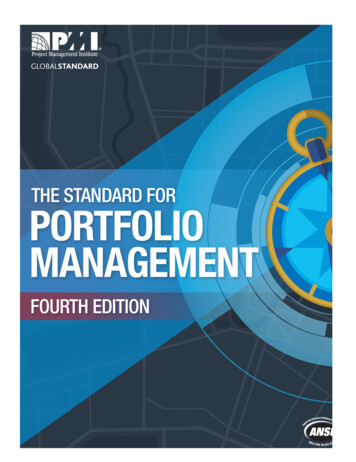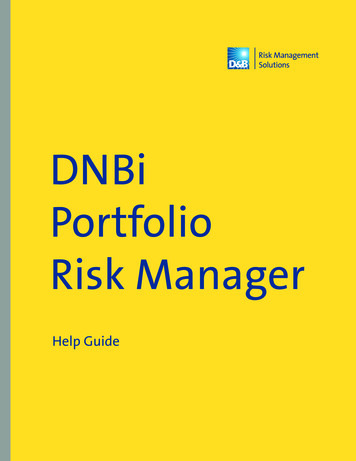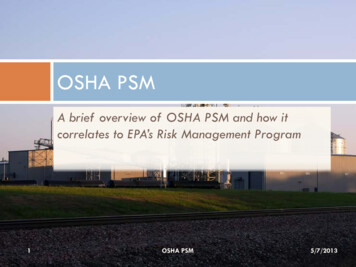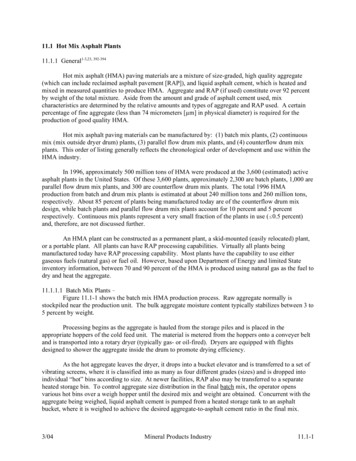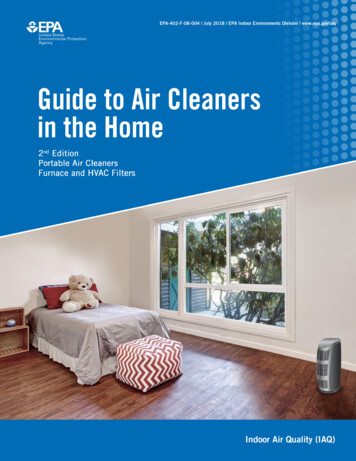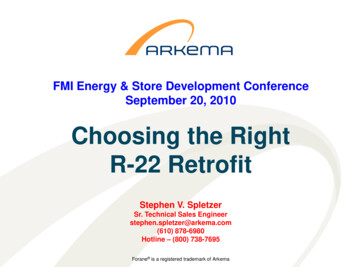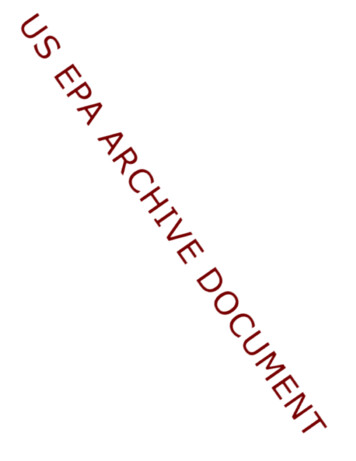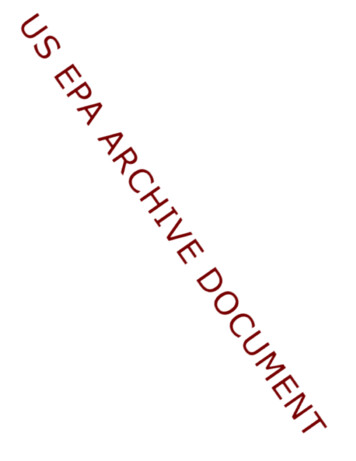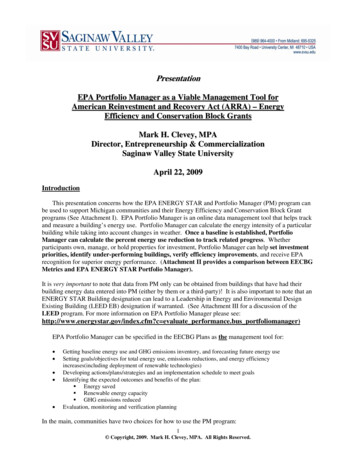
Transcription
PresentationEPA Portfolio Manager as a Viable Management Tool forAmerican Reinvestment and Recovery Act (ARRA) – EnergyEfficiency and Conservation Block GrantsMark H. Clevey, MPADirector, Entrepreneurship & CommercializationSaginaw Valley State UniversityApril 22, 2009IntroductionThis presentation concerns how the EPA ENERGY STAR and Portfolio Manager (PM) program canbe used to support Michigan communities and their Energy Efficiency and Conservation Block Grantprograms (See Attachment I). EPA Portfolio Manager is an online data management tool that helps trackand measure a building’s energy use. Portfolio Manager can calculate the energy intensity of a particularbuilding while taking into account changes in weather. Once a baseline is established, PortfolioManager can calculate the percent energy use reduction to track related progress. Whetherparticipants own, manage, or hold properties for investment, Portfolio Manager can help set investmentpriorities, identify under-performing buildings, verify efficiency improvements, and receive EPArecognition for superior energy performance. (Attachment II provides a comparison between EECBGMetrics and EPA ENERGY STAR Portfolio Manager).It is very important to note that data from PM only can be obtained from buildings that have had theirbuilding energy data entered into PM (either by them or a third-party)! It is also important to note that anENERGY STAR Building designation can lead to a Leadership in Energy and Environmental DesignExisting Building (LEED EB) designation if warranted. (See Attachment III for a discussion of theLEED program. For more information on EPA Portfolio Manager please see:http://www.energystar.gov/index.cfm?c evaluate performance.bus portfoliomanager)EPA Portfolio Manager can be specified in the EECBG Plans as the management tool for: Getting baseline energy use and GHG emissions inventory, and forecasting future energy useSetting goals/objectives for total energy use, emissions reductions, and energy efficiencyincreases(including deployment of renewable technologies)Developing actions/plans/strategies and an implementation schedule to meet goalsIdentifying the expected outcomes and benefits of the plan: Energy saved Renewable energy capacity GHG emissions reducedEvaluation, monitoring and verification planningIn the main, communities have two choices for how to use the PM program:1 Copyright, 2009. Mark H. Clevey, MPA. All Rights Reserved.
1. Encourage individual building owners to work independently with PM (SEE:http://www.energystar.gov/index.cfm?c business.bus internet presentations)2. Organize sector-wide PM programs so that data can be tracked and verified on an aggregate basisfor all those who participate in the PM program from individual sectors.Michigan Sector PM Pilot ProgramA Sector PM Program is where communities work to organize sector-wide PM programs so that datacan be tracked and verified on an aggregate basis for all those who participate in the PM program fromindividual sectors. A key benefit of a sector-wide program is the opportunity to lower the purchase priceof energy efficient products with an Aggregated Purchasing program.Under a grant from the U.S. EPA ENERGY STAR Congregations program,d the MichiganEnergy Office, and funding support from the Small Business Association of Michigan, such anaggregation program was piloted in Michigan with the Michigan Interfaith Power and Light, LLC(MiIPL). Father Charles E. Morris was the MiIPL project manager. In April 2008, MiIPL membersparticipated in a web-ex introduction to ENERGY STAR Portfolio Manager Training for Congregationswith Steve Bell of EPA. In March 2009, another PM training was conducted in Southeast Michigan inpartnership with the Detroit Deices and the Detroit Edison Company. Since Portfolio Manager has thecapability to track changes at the household level as well as facility level, MiIPL also partnered withPortfolio Manager and with the “Cool Congregations” program created by Iowa Interfaith Power & Lightto facilitate the process of lowered carbon footprints among individual congregants in their homes.The final report for this project presented the following outcome:TOTAL EMISSIONS REDUCTIONS TO DATE1C02 (Global Warming)S02 (Acid Rain)Nox (Smog)Particulates (Asthma/Heart Attack)Mercury (Cancer & Birth Defects) 17,354 Tons86 Tons42 Tons3,291 lbs.0.811 lbs.This comes to lifecycle savings of nearly 20,000,000 kilowatt-hours (kWh)or 2,427,265 on energy billsThis is the equivalent of planting 4,717 acres of forest or keeping 2445 carsoff of the road for a year(Report available upon request from the Small Business Association of Michigan (800) 362 5461).ENERGY STARThe ENERGY STAR program was created by the U.S. Department of Energy and U.S.Environmental Protection Agency to help consumers become aware of the ENERGY STAR concept andto promote the availability of ENERGY STAR products. ENERGY STAR helps consumers by providingan easily identified, third party verification of energy efficient products.ENERGY STAR is a registered trademark that indicates a product exceeds the minimum Federal1Michigan Interfaith Power and Light, LLC, July of 2004 and June of 2006 (lifecycle estimated offset).2 Copyright, 2009. Mark H. Clevey, MPA. All Rights Reserved.
energy use standards and/or uses less energy than similar products. ENERGY STAR products have highperformance, long life and a low environmental impact, as well as money saving, through lowermaintenance and utility costs over the life of the products. Energy Star products include: Appliances;Computers; Health Care; Manufacturing; Office Equipment; Restaurant/Food Services; buildings; andother products.The following is an example of Energy Star products appropriate for large, medium and smallbusinesses, home-based businesses, individuals, schools, non-profit organizations, homeowners, andrenters Energy Star Rated Computers - Power down when not in use. Laptops use even less energy thandesktops. Energy Star Rated Monitors have a large savings potential. Screen savers that are compatiblewith the monitor’s power management features. Annual Energy Star labeled Cost Savings: 19.00.Percentage of Total Operating Cost: 49%. Energy Star Rated Printers - Goes into sleep mode when not in use. Annual Energy Star labeled CostSavings: 39.00. Percentage of Total Operating Cost: 65%. Energy Star Rated Facsimile Machines - Saves 50% energy by going into a sleep mode when not in use.Annual Energy Star labeled Cost Savings: 13.00. Percentage of Total Operating Cost: 52%. Energy Star Rated Copiers - 60% savings on electricity by turning off after a period of inactivity.Annual Energy Star labeled Cost Savings – Medium Copier: 57.00, Large Copier: 130.00. Percentage ofTotal Operating Cost - Medium Copier: 57%, Large Copier: 58%. Energy Star Lights – Replacing twenty 100-watt incandescent bulbs used 24 hours a day in stairwayswith Energy Star 30-watt compact fluorescent bulbs will save 980 per year. The upgrade will cost 400. The simple payback is 400 divided into 908 0.4 years, or under 5 months. This is equivalent toan over 200 percent return on investment (ROI). Energy Star High-efficiency heating and cooling (HVAC) equipment can account for over 50 percentof a home's total energy use. A consumer can significantly lower utility bills by choosing equipmentcarefully. Energy Star Hot Water Heater - The average homeowner spends 200.00 per year on water heating.Energy Star rated Water Heaters can reduce this cost from 20.00 to 100.00 per year while also improvingsafety, quality and the value of the home. Energy Star Appliances - Comparison of Energy Star and non- Energy Star AppliancesAnnual Energy Cost (1)Refrigerators (18 – 20 C.F.) with Top FreezerNon ES (2)ES 63.00 50.00Dishwasher:1.2.3. (Electric Hot WaterGas Hot Water)Clothes Washer:(3) 47.00 26.00 42.00 24.00 Electric Hot WaterGas Hot Water) 83.00 32.00 39.00 17.00Based on price of 8.6 cents per kWh for electricity or 60.0 cents per therm for natural gas.Annual energy use for the Standard Model is sufficient to meet current federal appliance standards.WhirlPool Corporation Energy Star - While not factored into the above calculation, the new Whirlpool Resource Saver andCalypso washers can save up to 100 in annual water and energy costs. This does not account for added dry cleaning saving with theCalypso washer.3 Copyright, 2009. Mark H. Clevey, MPA. All Rights Reserved.
About Mark H. CleveyMark H. Clevey, MPADirector, Entrepreneurship & CommercializationSaginaw Valley State Universitymhclevey@svsu.edu1. Masters Degree in Public Administration2. Experience in Local Government, Energy and Economic Development3. Community Energy Management (CEM)oooCommunity Energy Manager, City of KalamazooCEM Consultant, City of Ann ArborManaged Renewable Energy Demonstration Program, County of Muskegon4. Co-Founder, Michigan Interfaith Power and Light, LLC.5. Founding Board Member, Michigan Solar Energy Association6. Director, State of Michigan, ENERGY STAR Promotion Program7. Consultant and College Instructor in Alternative Energy & Green Entrepreneurship.8. Industry Association experience in Alternative Energy and Energy Efficiency.9. Grant Manager on Renewable/Energy Efficiency grants from DOL, EPA, DOEn, State ofMichigan (MPSC, Energy Office, DNR).10. SBIR Phase II Commercialization Plan Grant Reviewer for U.S. Departments of Agriculture andEnergy, National Science Foundation and Environmental Protection Agency.11. Independent Trainer, EPA Portfolio Manager Program4 Copyright, 2009. Mark H. Clevey, MPA. All Rights Reserved.
5 Copyright, 2009. Mark H. Clevey, MPA. All Rights Reserved.
6 Copyright, 2009. Mark H. Clevey, MPA. All Rights Reserved.
AttachmentIIEECBG Metrics and EPA ENERGY STAR Portfolio ManagerEECBG MetricsEPA ENERGY STAR & Portfolio ManagerBuilding Codes and Standards Name of new code adopted Name of old code replaced Number of new and existing buildings covered by new codeTo qualify as an ENERGY STAR rated building, a building or manufacturing plant must score in the top25 percent based on EPA's National Energy Performance Rating System.EPA compares energy use among other, similar types of facilities on a scale of 1-100. Buildings thatachieve a score of 75 or higher may be eligible for the ENERGY STAR. Commercial buildings eligible toreceive a rating, representing over 50 percent of US commercial floor space, are:Bank/Financial InstitutionsCourthousesHospitals (acute care and children’s)HotelsK-12 SchoolsMedical OfficesMunicipal Wastewater Treatment PlantsOfficesResidence Halls/DormitoriesRetail StoresSupermarketsWarehouses (refrigerated and non-refrigerated)Building Retrofits Number of buildings retrofitted, by sector Square footage of buildings retrofitted, by sector Sector Strategy – Organize, train, and assist sectors (Industrial, Commercial, Residential, etc.) to usePortfolio Manager. PM serves as the Verification and Tracking Instrument.ENERGY STAR benchmarking is changing the building industry's perception of energyperformance. For commercial buildings, energy performance is rated on a 1-to-100 scale where a score of50 signifies energy performance better than 50 percent of similar buildings. Buildings withbenchmark scores of 75 or higher are eligible for the ENERGY STAR label for buildings to conveyperformance excellence to tenants, customers, and other occupants. Standards used in the ENERGYSTAR benchmarking for buildings include the following:7 Copyright, 2009. Mark H. Clevey, MPA. All Rights Reserved.
Clean Energy Policy Number of alternative energy plans developed or improved Number of renewable portfolio standards established or improved Number of interconnection standards established or improvedBuilding Energy Audits Number of audits performed, by sector Floor space audited, by sector Auditor’s projection of energy savings, by sectorEnergy Efficiency Rating and Labeling Types of energy-consuming devices for which energy-efficiencyrating and labeling systems were endorsed by the granteeEnergy efficiency in the top 25 percent of similar existing buildings, as indicated by a minimumscore of 75 out of 100 determined through the ENERGY STAR Portfolio Manager.Thermal comfort conditions based on the provisions in American Society of Heating,Refrigerating, and Air-Conditioning Engineers (ASHRAE) Standard 55-1992, ThermalEnvironmental Conditions for Human Occupancy.Indoor air quality through control of indoor air pollutants, proper ventilation, and adequatemaintenance, based on the provisions in ASHRAE Standard 62-1989, Ventilation for AcceptableIndoor Air Quality.Illuminance levels according to the Illuminating Engineering Society of North America, IESNALighting Handbook – 1999, Lighting Design Guide.PM has added a Renewable Energy component that identifies Renewable Energy usage.AN ENERGY AUDIT IS NOT AN END IN ITSELF! There is no shortage of UNUSED EnergyAudits in the libraries, offices and trash piles of building owners all across the state. Getting an energyaudit that is objective, easy to understand and whose recommendations are actually implemented is thechallenge. PM will identify what energy efficiency measures should be taken, and tracks theirimplementation and impact.The ENERGY STAR program was created by the U.S. Department of Energy and U.S. EnvironmentalProtection Agency to help consumers become aware of the ENERGY STAR concept and to promote theavailability of ENERGY STAR products. ENERGY STAR helps consumers by providing an easilyidentified, third party verification of energy efficient products. ENERGY STAR is a registered trademarkthat indicates a product exceeds the minimum Federal energy use standards and/or uses less energy thansimilar products. ENERGY STAR products have high performance, long life and a low environmentalimpact, as well as money saving, through lower maintenance and utility costs over the life of the products.The following are examples of ENERGY STAR products that can be used in existing or newbuildings to foster the efficient use of energy under an EEPS: Dehumidifiers - ENERGY STAR qualified dehumidifiers operate at least 10% more efficientlythan standard models. Dehumidifiers help remove excess moisture from basements and otherdamp areas of the home. ENERGY STAR qualified dehumidifiers provide enhanced moistureremoval as well as quiet operation, reliability, and durability. An ENERGY STAR qualifyingdehumidifier can save a Michigan homeowner as much as 840 over the 12-year lifetime of theirdehumidifier.Room Air Conditioners - Air conditioners that have earned the ENERGY STAR label use atleast 10% less energy than conventional models. Moreover, Thinking that a larger air conditioner8 Copyright, 2009. Mark H. Clevey, MPA. All Rights Reserved.
means more cooling power, customers often buy a unit that is too large for the space they wish tocool. (Check the ENERGY STAR Web site to determine which unit best meets your needs).Replacing a 10-year old room air conditioner with a new ENERGY STAR qualified model cansave up to 35 annually on a customer’s electricity bill. Dishwashers - Just as turning off the light when you leave a room can save energy, turning downthe thermostat on your water heater can do the same. An ENERGY STAR qualified dishwasherallows customers to turn down the thermostat of their water heaters from 140 to 120 degreesbecause water heaters inside the dishwasher boost the water temperature. By lowering thetemperature of the water heater, customers can prevent unexpected scald burns in the kitchen orbath. This extra feature also reduces heating costs up to 10 percent. ENERGY STAR qualifieddishwashers use up to 25% less energy than the federal minimum standard for energyconsumption. Replacing a 10-year old dishwasher with an ENERGY STAR labeled dishwashercan save a customer more than 30 a year in energy costs. The energy you save every year bypurchasing an ENERGY STAR qualified dishwasher is enough to brew nearly 9,000 cups ofcoffee. If every household in Michigan replaced their ten year old clothes washer with a newENERGY STAR qualifying model, the annual savings would be 905 million kWh/year, 77.6million therms/year, and 36.9 billion gallons of water per year. That is enough energy saved tolight a city the size of Lansing for 13.3 years and enough water saved for every Michiganresident to take 150 showers. Clothes Washers - ENERGY STAR qualified clothes washers use an average of 50% lessenergy and 40% less water than conventional washers. In one year, ENERGY STAR qualifiedclothes washers can save between 25 and 125 on your customer’s energy bill depending onyour customer’s water heater type and utility rates, between 20 and 35 on the water bill, and anaverage of 8,560 gallons of water every year. Depending on utility rates, total utility savingsrange from 65 to 160/year. ENERGY STAR qualified washers also remove more moisturefrom clothes, which reduces drying time. A shorter drying time means even greater energysavings. Meanwhile, the water a customer saves every year by purchasing a new ENERGYSTAR qualified clothes washer over another model is enough to do 12 month’s worth oflaundry. Designs used in ENERGY STAR qualified washers also cause less wear and tear onclothes, which means that clothes last longer. Refrigerators - Refrigerators use the most energy of any home appliance. A new ENERGYSTAR qualified refrigerator, however, uses less energy than a 75-watt light bulb left on for oneyear. To save money and energy, Sears’ customers can purchase an energy-efficient ENERGYSTAR labeled refrigerator, which are an average of 40% more efficient than conventionalmodels sold in 2001. Replacing a 10-year old refrigerator with an ENERGY STAR qualifiedmodel can cut a customer’s electricity bill by 25- 60 a year, depending on utility rates.9 Copyright, 2009. Mark H. Clevey, MPA. All Rights Reserved.
Government, School, Institutional Procurement Number of units purchased, by type (e.g., vehicles, officeequipment, HVAC equipment, streetlights, exit signs)Industrial Retrofit Support Number of buildings retrofitted, by Industry Type Square footage of buildings retrofitted, by Industry SectorLoans, Grants, and Incentives Number and monetary value of loans given Number and monetary value of grants given Number and monetary value of incentives providedENERGY STAR Rated Computers - Power down when not in use. Laptops use even lessenergy than desktops. ENERGY STAR Rated Monitors have a large savings potential. Screensavers that are compatible with the monitor’s power management features. ENERGY STAR Rated Printers - Goes into sleep mode when not in use. ENERGY STAR Rated Facsimile Machines - Saves 50% energy by going into a sleep modewhen not in use. ENERGY STAR Rated Copiers - 60% savings on electricity by turning off after a period ofinactivity.PM will allow BUILDING LEVEL EE measures to be tracked and their impacts verified.BUILDING LEVELNAIncremental Cost for Efficiency and Design Elements in NewBuildings Number and square footage of new buildings designed, by sector Number and square footage of new buildings constructed, bysectorRenewable Energy Market Development Number and size of solar energy systems installed Number and size of wind energy systems installed Number and size of other renewable energy systems installedFinancial Incentives for Energy Efficiency Monetary value of financial incentive provided, by sector Total value of investments incentivized, by sector Estimated impact of incentives on total investment madePortfolio Manager provides a platform to track energy and water use trends as compared with the costs ofthese resources. This is a valuable tool for understanding the relative costs associated with a given level ofperformance, helping you evaluate investment opportunities for a give
mhclevey@svsu.edu 1. Masters Degree in Public Administration 2. Experience in Local Government, Energy and Economic Development 3. Community Energy Management (CEM) o Community Energy Manager, City of Kalamazoo o CEM Consultant, City of Ann Arbor o Managed Rene

